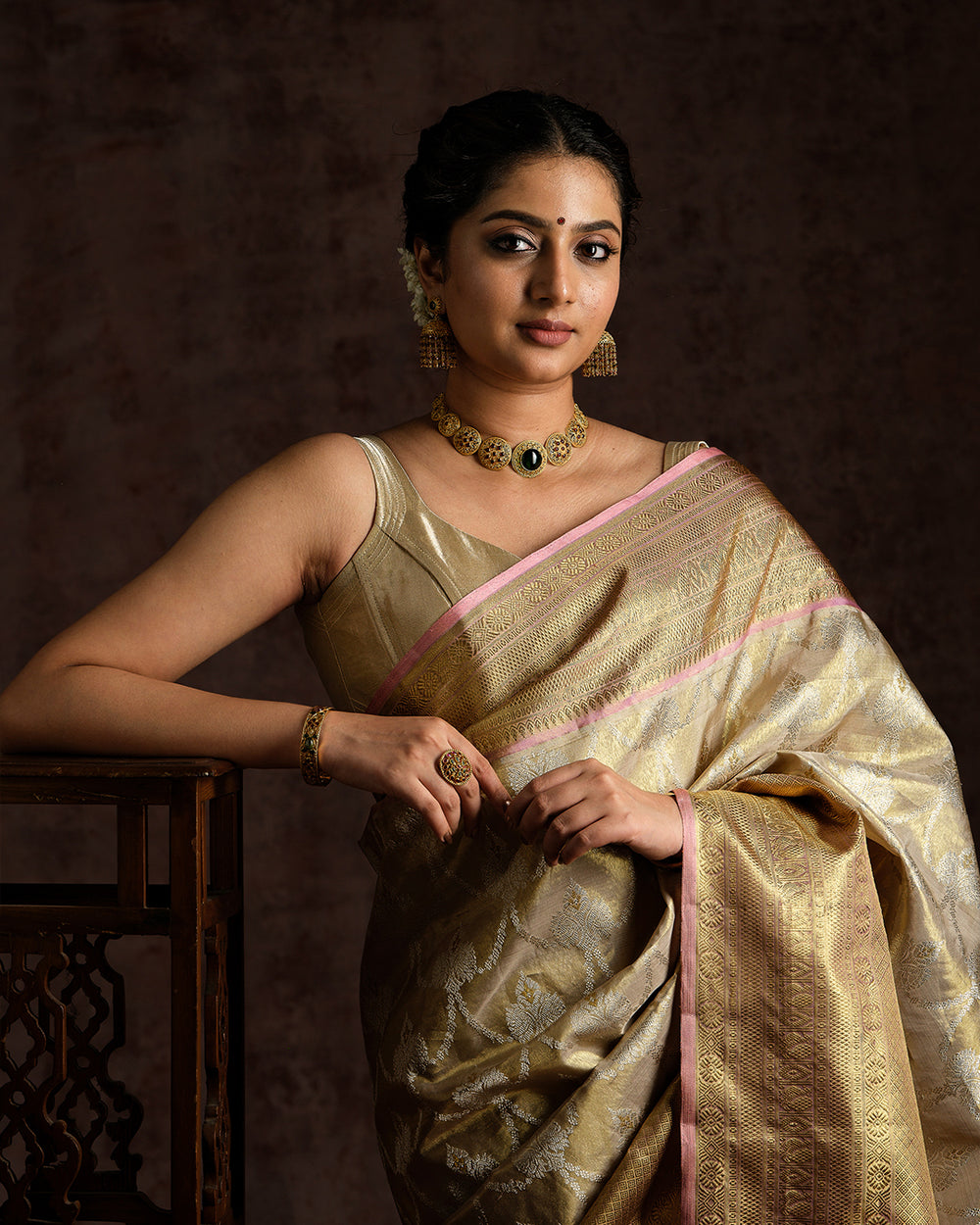Disha Madan at Cannes 2025: When a Legacy Kanjivaram Silk Saree Stole the Spotlight
What does it take to turn heads on the most glamorous red carpet in the world? For Kannada actress Disha Madan, it wasn’t sequins or a thigh-high slit—it was legacy. And silk. Specifically, a 70-year-old Kanjivaram silk saree brought back to life by the heritage custodians at The Saffron House.
At the 78th Cannes Film Festival, amidst the sea of designer gowns and glitzy couture, Disha Madan walked the red carpet draped in a story—a revived Kanjivaram silk saree woven decades ago in the heart of Tamil Nadu and reimagined for the now.
Let’s dive into how this moment wasn’t just about fashion, but about history, revival, and the art of slow, soulful luxury.
A Saree That’s Older Than Instagram—And Far More Iconic
This wasn’t just any Kanjivaram silk saree.
It began with a black-and-white photograph—an old bridal portrait from the 1950s, taken in Chettinad. The bride wore a deep vermillion Kanjivaram, its gold zari shimmering with a motif known as mayil chakram (peacock medallion). A classic of the time. A motif from Tamil temple architecture. A weave that whispered of prosperity, grace, and craftsmanship that modern machines just can’t replicate.
The Saffron House saw that photo and decided this piece deserved a second life. But not a replica—a resurrection. A revival.
From Memory to Masterpiece: The Revival Process
Reviving a legacy Kanjivaram silk saree isn’t just about copying patterns or colors. It’s about honoring sentiment, decoding lost techniques, and leaning on centuries of handloom wisdom.
It took months of archival digging, sourcing vintage zari threads, and working with weavers who had inherited their craft through generations. Woven on traditional looms using pure gold zari, the saree took over 400 hours of work. Each thread, each motif was a commitment—to culture, to artistry, to slowness.
And the final piece? A regal revival of everything that makes a Kanjivaram saree more than clothing—it was wearable heritage.
Anmol Ashok’s Red Carpet Remix
Now imagine you have a 70-year-old saree. How do you take that to Cannes and not look like you stepped out of a sepia-toned time capsule?
Enter Anmol Ashok, Co-Founder and Chief Designer at The Saffron House.
He saw the saree not as a limitation, but a canvas. Under his vision, it was transformed into a three-part statement piece:
- A hand-structured corset blouse, embroidered with threadwork over 250 painstaking hours by four karigars
- A reinterpretation of the pallu, made to flow like liquid on the red carpet, dramatic and fluid
- A translucent ruby-hued dupatta, sheer but structured, adding layers of volume and mystique
This wasn’t just styling. It was sculpture. Couture with a conscience.
Styled with Soul
Disha completed the look with heirloom emeralds, a bold nath, and that unmistakable energy that comes from wearing something rooted. No loud makeup. No OTT drama. Just a quiet majesty.
When asked why this piece mattered, Disha put it simply:
“This isn’t just fashion. This is memory made wearable. This is tradition, tailored for tomorrow.”
Why This Moment Mattered—for Kanjivaram, and for India
Cannes isn’t just a red carpet—it’s a global stage. And for Kanjivaram silk sarees, especially legacy pieces like this one, to be celebrated there says something powerful.
In a world where fast fashion reigns and trends change every scroll, a 70-year-old saree getting a standing ovation from global fashion critics is radical.
It challenges the narrative that luxury must be “new.” It proves that sustainability isn’t a trend, but tradition. And it places South Indian textile heritage shoulder-to-shoulder with Parisian couture.
Let’s be honest—when was the last time you saw a Tamil weave on a red carpet in France? Exactly.
Why Kanjivaram Sarees Will Never Go Out of Style
Here’s the thing: Kanjivaram silk sarees have always been iconic. But for years, they’ve been boxed into the “wedding only” category or thought of as heirlooms for grandmothers. Disha Madan just reminded us otherwise.
Let’s talk about why this weave continues to matter:
1. They’re built to last—literally.
With the right care, a Kanjivaram saree can outlive us all. That’s not an exaggeration; this Cannes piece is living proof.
2. They carry cultural weight.
Motifs aren’t just pretty patterns. Every check, every coin, every peacock in a Kanjivaram weave has meaning—often tied to temple architecture, South Indian myths, or rituals.
3. They adapt.
Modern blouses, newer drapes, fresh styling—legacy Kanjivaram sarees aren’t stiff.
The Saffron House: Not Just a Brand, Guardians of Tradition
What makes The Saffron House different is its core mission—to not just sell sarees, but resurrect India’s textile past with authenticity and reverence.
Founded by Meera Jagannatharaju, this isn’t a fast-fashion label. It’s a custodian of stories, rituals, and artistic memory. Every piece that leaves their studio has been curated, crafted, and revived with grace.
Their weavers aren’t employees—they’re collaborators. Their products aren’t collections—they’re narratives. And their design doesn’t chase novelty—it celebrates legacy.
Red Carpet, Real Impact
Since Cannes, the conversation around sustainable luxury and Indian weaves has picked up steam. Disha’s moment wasn’t just a photo op—it sparked global press, social media buzz, and renewed interest in reviving Kanjivaram silk sarees across generations.
This wasn’t a costume. It wasn’t kitsch. It was India, front and center. Regal, rooted, relevant.
What Disha Madan did at Cannes 2025 wasn’t just a fashion choice—it was a cultural moment. A reminder that India’s richness doesn’t need reinvention, just rediscovery
That’s not just a trend. That’s timeless.
Ready to revive your own legacy?
Book a private consultation with The Saffron House. Let your heritage shine—stunningly, sustainably, and globally.






